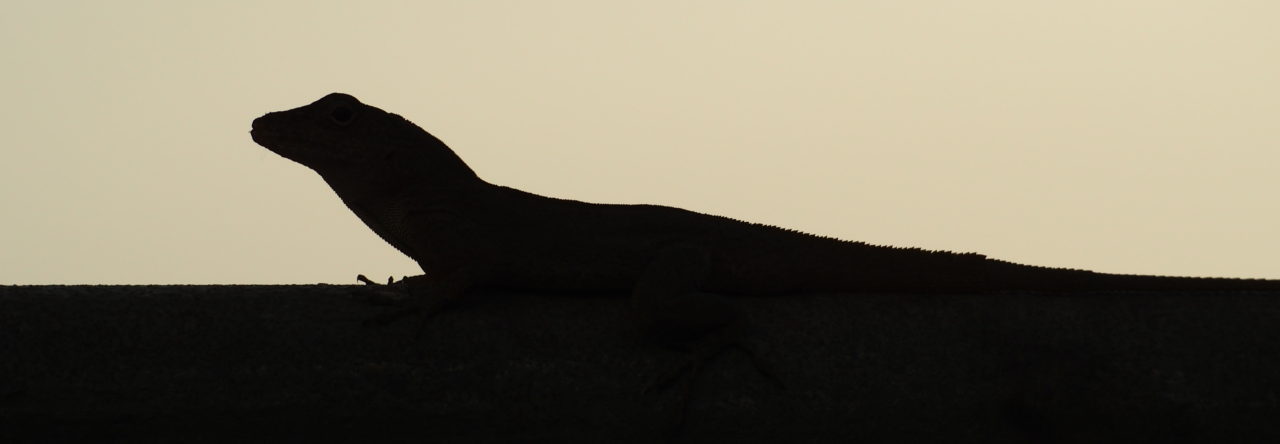
Hard at work studying lizards (from a previous AA post on best practices in lizard videotaping in the field)
The New York Times reported today on a recent paper in Nature Methods that indicated that stress levels of lab rats varied depending on whether the scientist in the room with them was a man or a woman. This effect existed even in response to t-shirts worn by a man or a woman.
This got me thinking: could the same factor effect lizard behavior studies? In many cases, anoles are studied by an observer quietly watching or recording lizards from a distance of a few meters. Many anole species seem unperturbed by the presence of observers and go about their activities in a seemingly natural way. But does the presence of an observer have an effect? Are they warier? Do they display less? And, more to the point, does the identity of the observer have an effect? Men are, on average, bigger than women, so might that matter? Some people are more fidgetty than others. Clothes? Facial hair? I am aware of a few studies on observer effects on lizard behavior (such as this one on the brown anole), but not many.
- Evolution in Real Time on Lizard Island - March 23, 2025
- Spider Snags Adult Anolis osa - March 22, 2025
- An Homage to the Green Anoles of New Orleans - March 21, 2025


Robert Heathcote
Really interesting post!
I’ve previously wondered about this with olfactory-oriented lizards, such as lacertids (aka Super-Anoles). For example, their scent mark secretions contain several compounds also found in human sweat, particularly the carboxylic acids produced by the bacteria communities found on hands. I wonder what affect simply noosing lizards and grabbing them in a sweaty palm has on social behaviour, particularly since individuals often tongue-flick one another during social interactions? Does this mean those of us who get more excited (sweatier palms) when noosing have bigger affects on lizard social behaviour?!
Regarding human gender differences, according to a very quick Google Scholar search, men sweat more from their hands than women, and men and women apparently differ a lot in the microbiota communities on their hands!
Kenneth Barnett
Just to banter… I would guess, before vision, the is also smell. Human female pheromones are widely reported to effect male iguana behavior.
Martha Muñoz
I don’t have a good feel for whether gender should matter to lizards, but I do have a hunch that the color of clothing might affect behavior. I had this electric pink running jacket that I would wear in the field until I noticed that the anoles seemed to act differently around me. They would head bob at me and run to hide at greater distances than they normally did. They seemed pretty annoyed by presence, more so than usual. I would have to observe them from much farther off than usual and even then I wasn’t sure they were behaving normally. So I just ditched the jacket and opted for more neutral tones. And no, this wasn’t Anolis carolinensis, which has a pink dewlap. This happened when I was studying Anolis shrevei, which has a dark brown body and a yellowish-white dewlap. I figured it must be the jacket, which was too bad because it was perfect for the cooler temperatures at this site. This is all purely anecdotal, I know, but when I got to thinking about it, it made sense to me. Anoles are very visual creatures and, to them, I was basically this gigantic, brightly-colored potential predator.
A study was retracted from PNAS once because, apparently, the butterflies they were studying were responding to the light reflecting off the researchers’ shirts rather than the magnetic fields of the experimental chamber they were put in. These things matter! It makes me really wonder what noise in our data could be out there that we’re not aware of yet.
Levi Gray
This is a cool observation. I feel like other lizards such as Sceloporus have responded differently depending on the color of shirt I was wearing. I haven’t done enough daytime work on anoles to have noticed anything yet, though.
Gotta be some cool experiments to be done in the field with this. How about it, island workers?
Martha Muñoz
A researcher wears different colored shirts and measures escape distance. Sounds like an easy undergrad project to me!
Mike B
I had also heard quite a few times about male green iguanas responding differently to men and women. David Marsh has a couple interesting papers on how gender biases human measurement of salamander behavior. It would be interesting to see if similar biases show up in studies measuring display behavior in Anolis and other lizards.
Marsh, D. M. and Hanlon, T. J. 2004. Observer gender and observation bias in animal behaviour research: experimental tests with red-backed salamanders. Animal Behaviour 68:1425-1433.
http://home.wlu.edu/~marshd/marsh%20ms/ab04.pdf